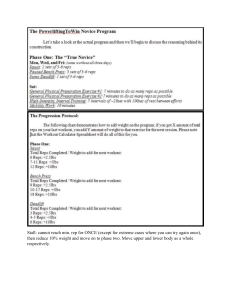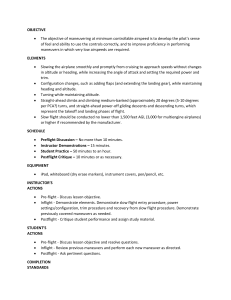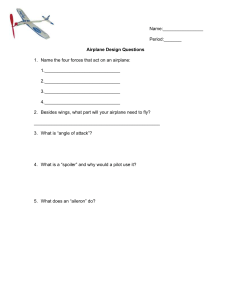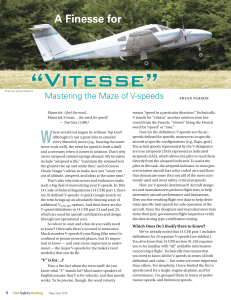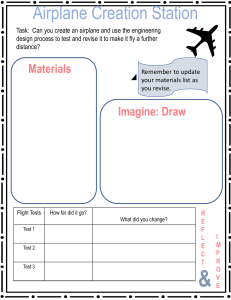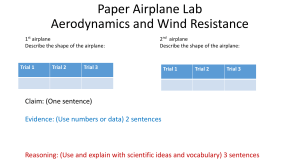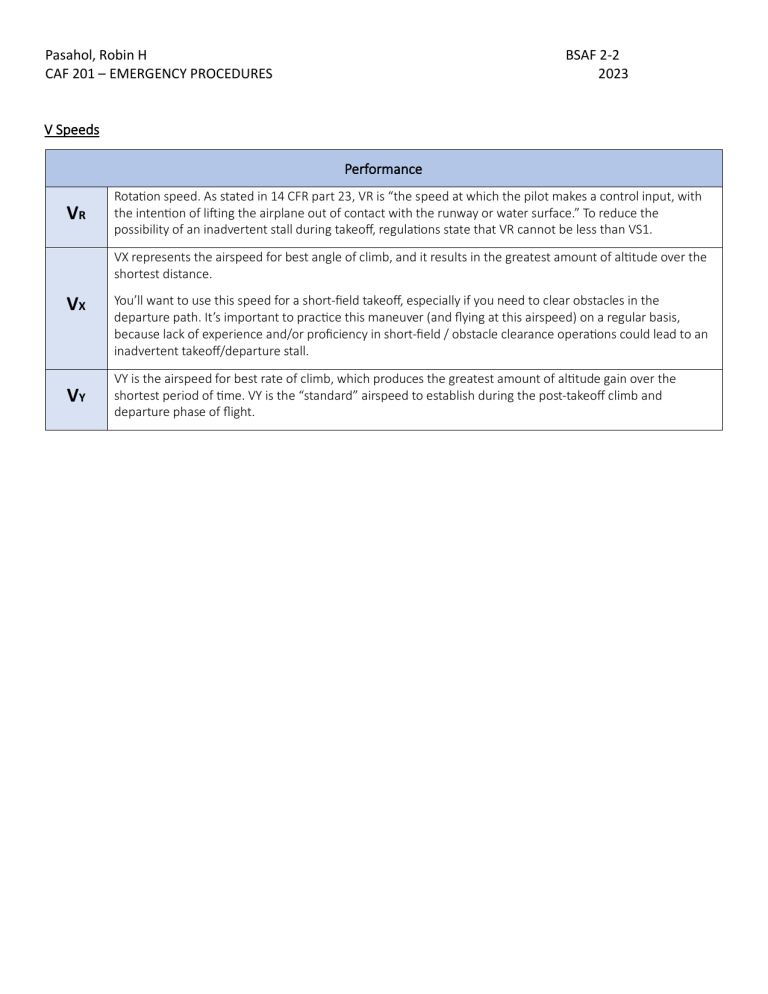
Pasahol, Robin H CAF 201 – EMERGENCY PROCEDURES BSAF 2-2 2023 V Speeds Performance VR Rota�on speed. As stated in 14 CFR part 23, VR is “the speed at which the pilot makes a control input, with the inten�on of li�ing the airplane out of contact with the runway or water surface.” To reduce the possibility of an inadvertent stall during takeoff, regula�ons state that VR cannot be less than VS1. VX represents the airspeed for best angle of climb, and it results in the greatest amount of al�tude over the shortest distance. VX VY You’ll want to use this speed for a short-field takeoff, especially if you need to clear obstacles in the departure path. It’s important to prac�ce this maneuver (and flying at this airspeed) on a regular basis, because lack of experience and/or proficiency in short-field / obstacle clearance opera�ons could lead to an inadvertent takeoff/departure stall. VY is the airspeed for best rate of climb, which produces the greatest amount of al�tude gain over the shortest period of �me. VY is the “standard” airspeed to establish during the post-takeoff climb and departure phase of flight. Limita�ons VA is the aircra�’s design maneuvering speed. Flying at or below VA, means that the airplane will stall before the structure is damaged by excessive loads. If you encounter a gust that causes a sudden, significant increase in load factor while flying above VA, the aircra� could experience structural failure. VA Another important thing to understand is that VA changes with the aircra� weight: VA decreases as weight decreases, and it increases as aircra� weight increases. It is a mistake to assume that as long as you are at or below VA, you can move the controls from stop to stop repeatedly without damaging the aircra�. To clarify this point, 14 CFR part 25 states that “flying at or below the design maneuvering speed does not allow a pilot to make mul�ple large control inputs in one airplane axis or single full control inputs in more than one airplane axis at a �me without endangering the airplane’s structure.” Although GA aircra� are cer�ficated under 14 CFR part 23, this point is s�ll valid. VFE Represented by the top of the white arc on the airspeed indicator, VFE is the maximum flap extended speed. If you allow your airspeed to increase above VFE with flaps extended, you may damage or even lose one or both flaps. Note that some aircra� are designed to allow par�al flap extension above VFE, so consult the Pilot Opera�ng Handbook/Aircra� Flight Manual to be sure you understand the limita�ons for your specific make and model. VLE VLE represents the maximum airspeed for opera�ng with the landing gear extended. A related speed is VLO, which is the maximum speed for “opera�ng” (extending or retrac�ng) the landing gear. VNE This one is easy – “never exceed” means exactly what it says. It is an absolute limit, and you should never, ever operate as if there were a “buffer” beyond this speed. Such assump�ons are likely to result in structural failure. VNO Maximum structural cruising speed — the highest speed that you can safely fly in smooth air — is shown as the upper limit of the green arc on the airspeed indicator. If you fly above VNO — in the yellow arc or “cau�on range” — and you encounter air that is not smooth, you could cause damage to the aircra�. VS VS is the stalling speed, or the minimum steady flight speed at which the airplane is controllable — in other words, the airplane will stall if you fly any slower than this speed. Although the “stalling speed” part of the defini�on leads pilots to believe they can avoid a stall by flying at or above a specific numerical value, it is very important to understand that a stall results from exceeding the cri�cal angle of atack. It’s beter to think of VS not as a numerical value, but rather the point at which your airplane is at the cri�cal angle of atack in straight-and-level flight. A stall can occur at any airspeed, in any a�tude. VS is the point at which the air flowing over the upper surface of the wing can no longer flow smoothly to the trailing edge. 2 V-speeds defined in 14 CFR part 1 VA VB VC VD VDF/MDF VEF VF VFC/MFC VFE VFTO VH VLE VLO VLOF VMC VMO/MMO VMU VNE VNO VR VREF VS VS0 VS1 VSR VSR0 VSR1 VSW VTOSS VX VY V1 V2 V2min design maneuvering speed design speed for maximum gust intensity design cruising speed design diving speed demonstrated flight diving speed speed at which the cri�cal engine is assumed to fail during takeoff design flap speed maximum speed for stability characteris�cs maximum flap extended speed final takeoff speed maximum speed in level flight with maximum con�nuous power maximum landing gear extended speed maximum landing gear opera�ng speed li�-off speed minimum control airspeed with the cri�cal engine inopera�ve maximum opera�ng limit speed minimum uns�ck speed never-exceed speed maximum structural cruising speed rota�on speed reference landing speed stalling speed or minimum steady flight speed at which the airplane is controllable stalling speed or minimum steady flight speed in the landing configura�on stalling speed or minimum steady flight speed obtained in a specific configura�on reference stall speed reference stall speed in the landing configura�on reference stall speed in a specific configura�on speed at which onset of natural or ar�ficial stall warning occurs takeoff safety speed for Category A aircra� speed for best angle of climb speed for best rate of climb maximum speed in the takeoff at which the pilot must take the first ac�on (e.g., apply brakes, reduce thrust, deploy speed brakes) to stop the airplane within the accelerate-stop distance. V1 also means the minimum speed in the takeoff, following a failure of the cri�cal engine at VEF, at which the pilot can con�nue the takeoff and achieve the required height above the takeoff surface within the takeoff distance. takeoff safety speed minimum takeoff safety speed 3 4
